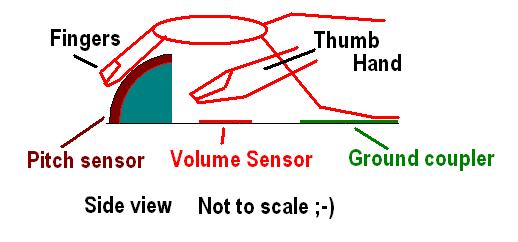OT - Not about the Theremini
Hi Peter,
Yeah, its a bit like the continuum I guess, but much simpler - Monophonic, and only sensitive to one parameter - capacitance - which is determined mainly from position (x axis) and a little by proximity / area.. Its a theremin antenna which mainly detects along its length and not by distance.
And MUCH cheaper ;-) entirely passive, it consists of a fancy network of ovelapping capacitive plates which are individually trimmed to get linearity, so one can get as many octaves as you want - (not user trimmable - one would make the required length in the factory and tune it there)
Antenna tuning would be for a specific theremin - any theremin could be fitted, but practically it will be best to have one design so that the antenna strip can be standardised for this and trimming minimised (or possibly eliminated) - I am looking at about 1.25cm per semitone, giving 5 octaves for a 75cm strip, and up to 8 octaves with a 1.2 metre strip.. The theremin will need to be capable of the range required... I want 16Hz to 4096Hz.. ;-)
But from the theremins perspective, its just an antenna.. And the astounding thing about it is its simplicity - this could have been produced in the 30's !
Fred.
I have just watched your continuum "demo" - Ive seen demos of this instrument before, but this is the first where a monophonic "lead" was being played..
Its superb -
As I understand it though, its got "key" positions which can be "detuned" or "bent" - yet your opening scene you were sliding it as though it had no key "assignments".. Then you played it "as if" it was a keyboard ... bending individual notes etc..
It looks to me like there were two different modes in operation.. Or were you actually 'landing' on precicely the right points on the board to get the perfect pitches you did ? .. You see, for me, even with visual cues, I would still need audio preview to do what you were managing... (well no.. I could probably never do what you were managing, but you know what I mean ;-)
My horizontal antenna behaves a bit like your opening 'gliding' scene - pressure only affects pitch not volume (actually, I am exploring having a seperate sensor "track" so that the thumb controls the volume - I find this really instinctive - moving the thumb above this strip with about 7cm from max to min volume, and having a raised pitch sensing antenna about 3cm above the volume sensor strip - the other fingers are bent over the pitch sensor which is curved and facing away from the player..
But I will still need preview - because one can raise the pitch by an octave if one has 4 fingers on the strip rather than one, or one varies finger distance or pressure - One only gets linear note spacing if one slides a fixed finger configuration on the sensor with a consistant distance or pressure.. And if one moves all fingers from the sensor more than about 5mm, one rapidly gets into extremely non-linear area - pitch dropping by octaves - and this gets more extreme the further from the bass end of the antenna one gets...

Still a lot of work to be done ( I have only messed with proof of concept really - cutting tiny pieces of aluminium tape, shaping these with a craft knife,overlaying cellotape, placing the layers, trimming - days of work just to get the tiny capacitances "right enough" that I have reason to believe it will work..) - but its ok if one keeps ones fingers lightly touching the sensor. (ground coupler is just a full copper fill to capacitively improve performance - does not need to make contact)
*Many of the "details" (if not all) that I give in this and the last post may be inaccurate - LOTS of simulation has been done, but little other than proof-of-concept has been built, and so lots of what I say is speculative. I have no possible way to fund full development, my hope is that I can afford a prototype and get crowd funding through this.



